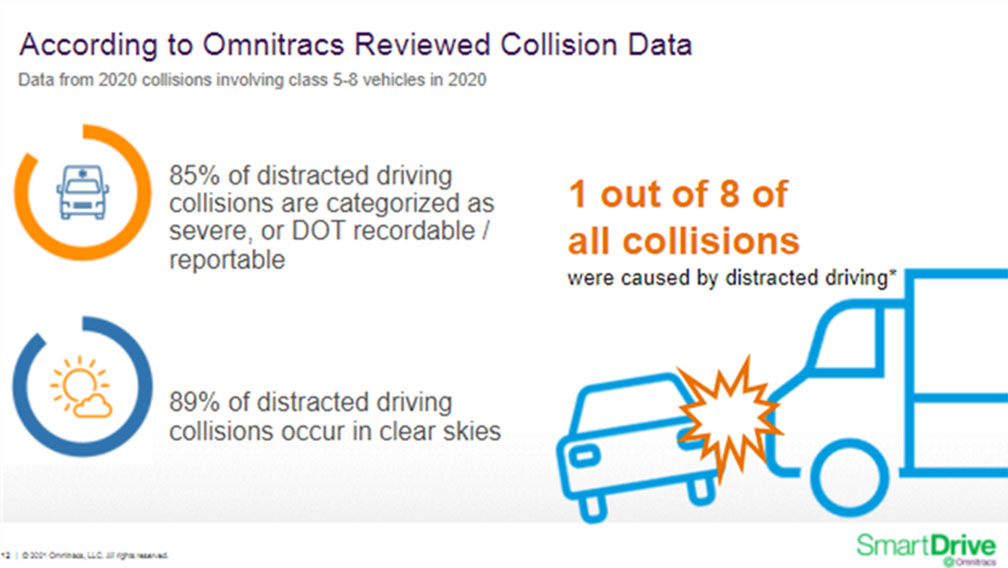Written by Don Osterberg, safety advisor to Omnitracs
We all know we’re not superheroes, impervious to pain. But frequently, we fall victim to bad habits behind the wheel and engage in driving behaviors as if we’re invincible — often without realizing it.
Drowsy and distracted driving have resulted in a longstanding epidemic that has only worsened with the coupling of our misplaced enthusiasm for multitasking and now-continuous connection to technology.
On July 27, Don Osterberg, safety advisor at Omnitracs, and Jeff Griswold, Omnitracs director of product management, joined forces to host the 4 Actions to Eliminate Drowsy or Distracted Driving webinar.
Osterberg is a recognized authority on carrier safety, while Griswold has managed Omnitracs’ SmartDrive suite of fleet safety solutions — including video-based safety — since 2014. Read on for several top insights from the webinar.
Deciphering differences between drowsy and distracted driving
According to the National Safety Council, truck-involved fatalities increased by nearly 50% from 2009 to 2019, with drowsy and distracted driving both topping the list of causal factors resulting in high-severity crashes.
The terms “drowsy” and “distracted” describe two distinctive behaviors that are interrelated. Drowsy driving pertains to fatigue-like behaviors and dangers, while distracted driving focuses on manual, visual and cognitive distractions, such as cellphone use and smoking.
Many of us are unaware of how drastically drowsiness alters our alertness and responsiveness. The Centers for Disease Control and Prevention (CDC) states that being awake for 24 hours is the same as having a blood alcohol content of .10% — which is higher than the legal limit in the U.S. The estimated societal cost of fatigue-related crashes and injuries is $109 billion every year, according to the Insurance Information Institute. Researchers concluded this in 2016, when one of the most recent comprehensive studies on this subject was conducted. Now, in 2021, this metric is likely much higher.
Distracted driving metrics don’t fare much better. The National Highway Traffic Safety Administration notes that sending or reading a text takes your eyes off the road for at least five seconds — enough time to drive about the length of a football field. Imagine driving through a football field with your eyes sealed tight. Suddenly, answering that text may not seem so important.
Every driver is susceptible to drowsy or distracted driving dangers. Still, commercial drivers often operate heavy vehicles, balancing long workdays with multiple day-to-day tasks against the backdrop of extreme supply chain pressure for on-time deliveries. Understanding and eliminating dangerous driving behaviors in the fleet world is critical to driver safety, road safety and driver retention.
What distracted or drowsy driving looks like up close
One common element of drowsy or distracted driving is a perception of invincibility. Most professional drivers undoubtedly take their roles and commitment to safety seriously. But we’re all human, susceptible to habit and fatigue. We can often slip unknowingly, pushing on for “just one more hour” or pressing “send” on a text message. We may think, “I know bad things can happen, but I don’t believe it’ll happen to me today.” Or we may tell ourselves, “I’ve driven tired before, and nothing bad happened, so I’ll fight through it.”
To avoid this, we must identify three different kinds of distractions:
- Manual,
- Visual and
- Cognitive.
Manual distractions involve taking your hands away from the wheel to eat, drink or smoke. Visual distractions lead to you taking your eyes away from the road to do something like search for items in the cab or adjust your non-cab-compatible GPS. Cognitive distractions result in your mind wandering away from your driving task due to road rage or speaking on your cellphone.
Interestingly, as our data shows below, nearly 90% of these distractions happen under clear skies and in the daytime.

The standard in post-crash litigation today is to ask carriers what they could have done to prevent collisions. The paradigm has shifted, and many de-facto standards of care have emerged. Carriers can protect drivers and keep their business brand — and profits — out of the courtroom with help from comprehensive safety, security and video solutions.
Steps to mitigate distracted or drowsy driving
Fleet leaders can combine leading transportation technology with successful safety management and driver coaching practices to reduce distracted or drowsy driving.
Other actions leaders can take include:
- Prioritize a strong culture of safety by making safety a core value, not just a priority. Carriers should also consider creating a no-cellphone use policy.
- Educate family members to eliminate unnecessary phone calls to their driver, and make sure they truly understand the risks drowsy or distracted driving pose to their loved ones. Also, leaders should tell family members to encourage quality, restorative sleep for professional drivers. Finally, family education on the signs and symptoms of obstructive sleep apnea will result in drivers being tested and treated for this common, fatigue-causing illness.
- Utilize a video-based safety solution that alerts drivers as they unknowingly fall victim to habit. This lets drivers alter their behavior before a severe incident and provides personalized insights and training tailored to their unique behaviors, so they are empowered to improve their driving skillsets.
- Offer drivers a leading commercial vehicle navigation application mounted in a location that’s easy to see, so that they don’t have to fiddle with the GPS on their phone or read a map or road signs.
The safest carriers use leading safety, security and video solutions to reduce crash frequencies and avoid nuclear verdicts. One leading carrier Omnitracs partnered with reduced crashes by 60%, while another carrier generated a whopping 11 exonerations in one year.
The bottom line is clear: To reverse the negative trends in truck-involved injury and fatality crashes, we must do more and be better. As transportation professionals, we have a moral obligation to do so. The greatest risk today is doing nothing.
There are proven technologies available today that result in improved safety. Ask yourself, “If we had a driver who was driving drowsy or distracted, would we want to know?” If you want to know, there are ways today that you can.
We owe it to both our drivers and the motoring public to operate as safely as we can.
The discussion with Don Osterberg and Jeff Griswold included many more valuable tips as well as downloadable resources for your drivers, so tune in to the entire webinar to learn more about how you can mitigate risk for your fleet and empower your drivers to improve!
The Trucker News Staff produces engaging content for not only TheTrucker.com, but also The Trucker Newspaper, which has been serving the trucking industry for more than 30 years. With a focus on drivers, the Trucker News Staff aims to provide relevant, objective content pertaining to the trucking segment of the transportation industry. The Trucker News Staff is based in Little Rock, Arkansas.















